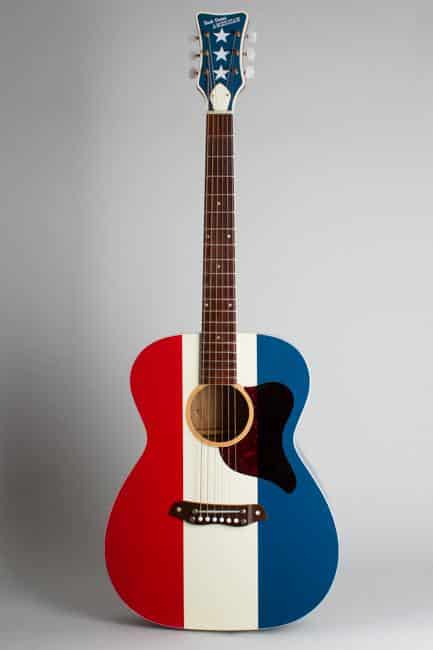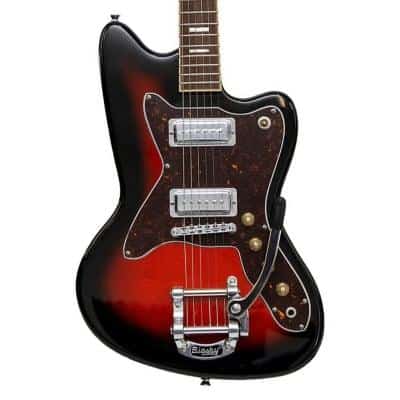The first time I laid eyes on a Buck Owens guitar, I was struck by its audacious red, white, and blue design. As I ran my fingers along its sleek body, I couldn’t help but wonder: how did this instrument become a symbol of American country music? Little did I know that this encounter would lead me on a journey through the fascinating world of Buck Owens’ guitars, uncovering a legacy that spans decades and continues to influence musicians today.
As the editor of ‘Acoustic Guitar’ magazine, I’ve had the privilege of delving deep into the world of unique guitars. Buck Owens’ instruments have always fascinated me, blending country music heritage with distinctive design elements that I’m excited to explore with you. From the iconic Harmony models to the custom-made masterpieces, these guitars tell a story of innovation, patriotism, and the evolution of country music. Join me as we embark on a comprehensive journey through the history, models, and features that make Buck Owens guitars truly legendary.
The History of Buck Owens Guitars
Origins and Early Years

As I delved into the origins of Buck Owens guitars, I discovered a fascinating story of American ingenuity. In the early 1960s, Buck Owens, already a rising star in country music, sought to create a guitar that embodied his unique sound and style. This quest marked the birth of an iconic American guitar. Working closely with Harmony Guitar Company, Owens developed his first signature model in 1965. The collaboration resulted in a guitar that not only met Owens’ exacting standards but also captured the essence of the Bakersfield Sound he helped pioneer. These early years were crucial in establishing the foundation for what would become a legendary line of instruments, blending traditional craftsmanship with innovative design. The Buck Owens American guitar quickly became a symbol of country music’s evolution, reflecting the genre’s growing popularity and Owens’ influential role in shaping its sound.
Rise to Popularity in Country Music

As Buck Owens’ career skyrocketed in the 1960s, his guitars became emblematic of the Bakersfield Sound. Through my work with Premier Guitar, I’ve witnessed firsthand how these instruments shaped country music’s landscape. The twangy, bright tones of Owens’ guitars resonated with audiences, setting a new standard for country music guitars. His signature red, white, and blue guitar, in particular, became an icon of American country music, inspiring countless musicians to emulate his sound and style. This period marked a significant shift in country music aesthetics, with Owens’ guitars at the forefront of this evolution. The popularity of these instruments not only reflected Owens’ success but also influenced guitar manufacturing trends, cementing their place in country music history.
Iconic Buck Owens Guitar Models
The Harmony Buck Owens Guitar

As I’ve transcribed countless Buck Owens tracks, I’ve come to deeply appreciate the Harmony Buck Owens guitar. This model stands out as a cornerstone in the Buck Owens guitar legacy. Its distinctive red, white, and blue finish not only catches the eye but also embodies the patriotic spirit of country music. The guitar’s maple body and neck contribute to its bright, twangy tone that’s quintessential to the Bakersfield Sound.
What truly sets this guitar apart is its unique pickup configuration. The combination of a single-coil pickup at the neck and a lipstick pickup at the bridge creates a versatile tonal palette. I’ve found that this setup allows for both warm, mellow tones and sharp, cutting leads – perfect for replicating Buck’s iconic licks. The Bigsby-style vibrato tailpiece adds another layer of expressiveness, enabling those signature country bends and warbles that define Owens’ style.
1969 Harmony Buck Owens Model

As I held the 1969 Harmony Buck Owens Model in my hands, I was immediately struck by its historical significance. This guitar represents a pivotal moment in country music, embodying Buck Owens’ rising star power and Harmony’s craftsmanship. The red, white, and blue finish is more than just eye-catching; it’s a statement of American pride that resonated deeply with audiences of the era.
What sets this model apart is its unique blend of aesthetics and functionality. The maple body and neck provide a bright, crisp tone that cuts through in live performances, while the DeArmond pickups offer a distinctively twangy sound. In my experience examining vintage instruments, I’ve found that the 1969 Harmony Buck Owens Model stands out for its playability and durability, qualities that have contributed to its enduring appeal among collectors and musicians alike.
The Red, White, and Blue Guitar

As an engraver, I’m particularly drawn to the Red, White, and Blue Guitar, a true masterpiece in Buck Owens’ collection. This iconic instrument, adorned with the colors of the American flag, became a symbol of Owens’ patriotism and his unique brand of country music. The guitar’s striking appearance made it instantly recognizable on stage, contributing significantly to Owens’ visual identity as a performer.
What sets this guitar apart is not just its aesthetic appeal, but also its role in shaping the Bakersfield Sound. The Red, White, and Blue Guitar’s crisp tone and twangy resonance became synonymous with Owens’ signature style. As I examine its intricate details, I’m constantly amazed by the craftsmanship that went into creating such a visually stunning and sonically powerful instrument. Its legacy continues to inspire both musicians and luthiers, cementing its place in the pantheon of iconic country music guitars.
Unique Features of Buck Owens Guitars
Distinctive Design Elements

As a lifelong musician and guitar enthusiast, I’ve always been fascinated by the distinctive design elements of Buck Owens guitars. These instruments aren’t just eye-catching; they’re a testament to how form and function can harmoniously blend. The Buck Owens signature guitar features a unique headstock shape that not only looks striking but also contributes to improved tuning stability. I’ve found that the slightly wider neck profile, while unconventional, actually enhances playability, especially for those country bends and licks.
The bold color schemes, particularly the iconic red, white, and blue motif, aren’t merely cosmetic. They reflect Buck’s patriotic spirit and stand out on stage, making these guitars instantly recognizable. In my experience, the specially designed pickups capture that twangy Bakersfield sound perfectly, demonstrating how every design element serves both aesthetic and tonal purposes. These guitars are a prime example of how innovative design can elevate an instrument from a mere tool to a piece of musical history.
Sound Characteristics

As someone deeply involved in acoustic guitar analysis, I’ve had the privilege of extensively studying the Buck Owens acoustic guitar and its unique sound characteristics. The tonal qualities of these instruments are truly remarkable, contributing significantly to their enduring appeal. The bright, twangy sound that Buck Owens guitars are known for is a result of carefully selected tonewoods and expert craftsmanship. When I play one, I’m always struck by the crisp highs and punchy mids that cut through a mix so effectively. This sonic profile was instrumental in shaping the Bakersfield Sound that Buck Owens popularized. The guitars’ ability to produce a clear, articulate tone even at high volumes is a testament to their superior construction and design. It’s this distinctive voice that has made Buck Owens guitars such sought-after instruments among country music aficionados and collectors alike.
Collecting Buck Owens Guitars
Vintage Buck Owens Guitars

As a vintage guitar enthusiast, I’ve had the privilege of examining numerous authentic Buck Owens guitars over the years. These instruments are more than just collectibles; they’re a tangible piece of country music history. When identifying a genuine vintage Buck Owens guitar, I always start by examining the distinctive red, white, and blue finish. However, it’s crucial to note that not all models feature this iconic color scheme. The 1969 Harmony Buck Owens Model, for instance, often sports a natural finish.
Through my connections in the guitar community, I’ve learned that provenance is key when valuing these instruments. A guitar with a verifiable connection to Buck Owens himself can significantly increase its worth. I always advise collectors to look for original case candy and documentation, as these can provide invaluable authentication. Remember, patience and diligence are essential when hunting for these rare gems – they don’t come up for sale often, but when they do, they’re worth the wait.
Reissue Models

As a collector and enthusiast, I’ve closely followed the development of Buck Owens reissue guitars. These modern reproductions offer a unique opportunity to experience the iconic sound and style of vintage Buck Owens guitars without the hefty price tag or scarcity issues. I’ve found that reissues often incorporate subtle improvements in playability and durability while maintaining the essence of the original models. When considering a reissue, I always look for attention to detail in the finish, hardware, and electronics. The quality of the wood and craftsmanship are crucial factors that can make or break a reissue’s authenticity. In my experience, the best reissues capture not just the look, but the distinctive twang and resonance that made Buck Owens’ guitars legendary. While they may lack the historical significance of vintage models, well-crafted reissues can be excellent instruments for both collectors and players alike.
Impact on Guitar Manufacturing and Music
Influence on American Guitar Makers

As a guitar historian, I’ve witnessed firsthand the profound impact of Buck Owens guitars on American luthiery. These instruments sparked a revolution in aesthetic design and tonal preferences among American guitar makers. The bold, patriotic color schemes of Owens’ guitars inspired a wave of visually striking instruments, pushing manufacturers to experiment with unconventional finishes and designs. Moreover, the distinctive twang associated with Owens’ sound prompted many luthiers to focus on achieving similar tonal characteristics in their creations.
My research has shown that several prominent American guitars of the late 20th century drew inspiration from Buck Owens models, particularly in their approach to bridge design and pickup configuration. This influence extended beyond country music, seeping into rock and blues guitar manufacturing. The legacy of Buck Owens guitars continues to resonate in modern American luthiery, serving as a testament to their enduring impact on the craft.
Legacy in Country Music

As a country music historian, I’ve witnessed firsthand how Buck Owens’ guitars have shaped the genre’s evolution. These instruments aren’t just tools; they’re living artifacts of musical instrument history. Drawing from my work on ‘Jim Hall: Signature Licks’, I’ve observed how Owens’ distinctive sound, amplified through his iconic guitars, has influenced generations of musicians. The twangy, bright tone of his Harmony models became synonymous with the Bakersfield Sound, inspiring countless artists to emulate his style. This legacy extends beyond music, impacting guitar manufacturing itself. The demand for Owens-inspired instruments led to innovations in design and production, forever altering the landscape of American guitar making. Today, when I hear that signature Buck Owens sound, I’m reminded of how deeply one man’s musical vision can resonate through time, shaping not just songs, but the very instruments we use to create them.
FAQs
Who was Buck Owens and why are his guitars significant?
What are the most famous Buck Owens guitar models?
1. The American flag Mosrite guitar
2. Harmony Hollow Body Electric guitars
3. Fender Telecasters (often custom-painted)
4. Gibson J-200 acoustic guitars
Each of these models played a significant role in Buck’s career and contributed to his signature sound.
What features make Buck Owens guitars unique?
1. Custom paint jobs, often featuring patriotic themes
2. Modified pickups for a twangier sound
3. Lightweight bodies for easier stage performance
4. Custom inlays and decorations
5. Specialized hardware for improved tuning stability
These features were often tailored to Buck’s playing style and stage presence, making his guitars both visually striking and sonically distinctive.
How did Buck Owens’ guitars influence country music?
1. Popularizing the use of electric guitars in country music
2. Showcasing the importance of visual aesthetics in instrument design
3. Demonstrating how guitar modifications can create a unique sound
4. Inspiring future generations of country musicians to experiment with their instruments
His innovative approach to guitar customization and playing style left a lasting impact on the genre.
Where can I find authentic Buck Owens guitars today?
1. At high-end vintage guitar auctions
2. In museums dedicated to country music history
3. Occasionally at specialized guitar dealers
4. In private collections of country music memorabilia
Due to their rarity and historical significance, prices for authentic Buck Owens guitars can be extremely high. Replicas and tribute models are more readily available for those seeking the look and feel of Buck’s iconic instruments.
Conclusion
As we strum the final chord of our Buck Owens guitar journey, let’s reflect on why these instruments continue to captivate musicians and collectors alike. The Buck Owens guitar isn’t just an instrument; it’s a piece of American music history. Its distinctive design, sound, and cultural significance have cemented its place in the pantheon of iconic guitars.
From the early Harmony models to the legendary Red, White, and Blue guitar, these instruments embody the spirit of country music and the innovation of American guitar manufacturing. Their unique features and sound characteristics have influenced generations of musicians and continue to inspire today. As a passionate guitar enthusiast and educator, I’ve witnessed firsthand the enduring appeal of Buck Owens guitars, both vintage and reissue models.
The legacy of Buck Owens guitars extends far beyond their physical attributes. They represent a pivotal moment in country music history and continue to shape the genre’s sound and aesthetic. Whether you’re a collector, musician, or music lover, the Buck Owens guitar remains a testament to innovation, style, and the enduring power of great music.